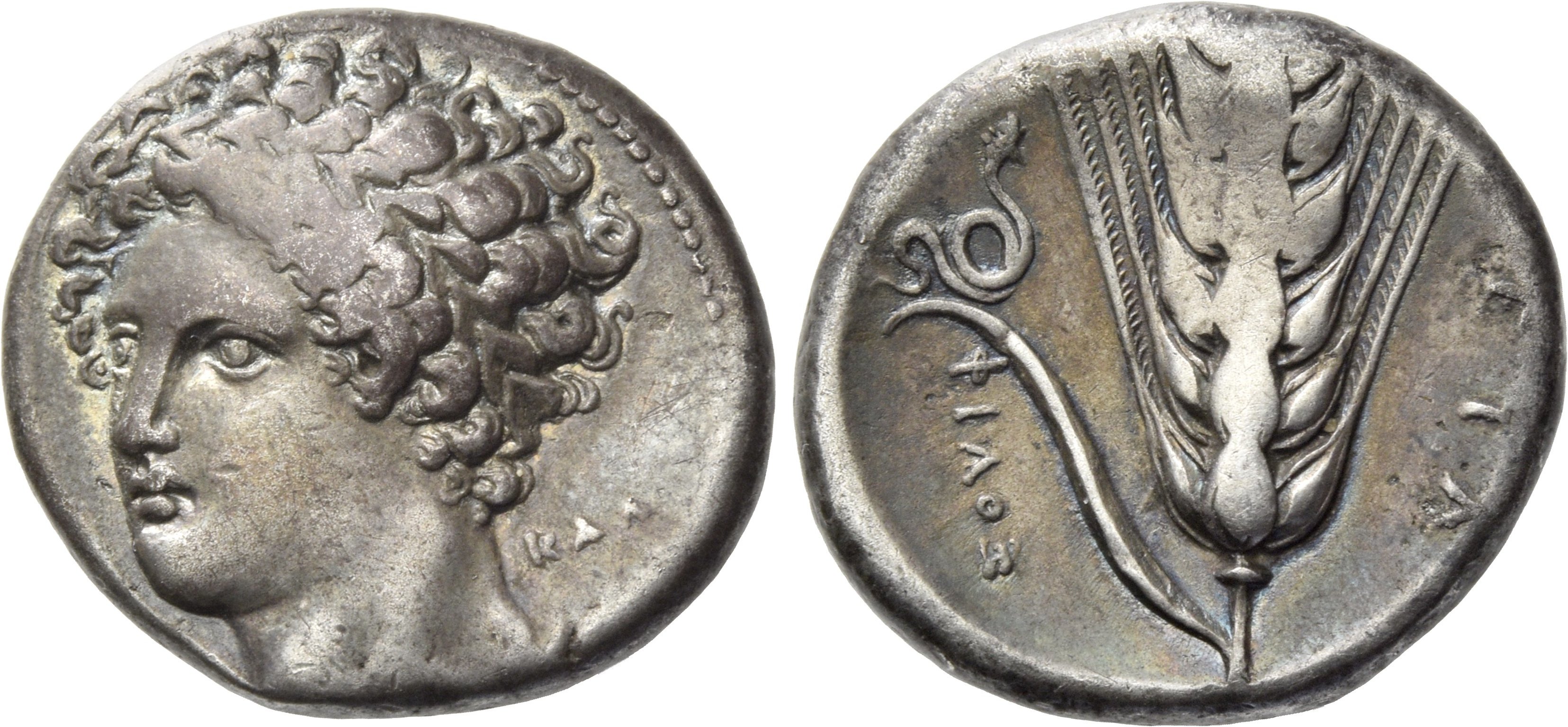Metapontum, silver, didrachms (340-330 BCE)
From SILVER
340 BCE - 330 BCE Silver 8,964 kg
Description
| ObverseInscription or printing placed on the obverse.: | Various heads. Laureate head of Apollo, facing three-quarters l., behind the neck, KAΛ |
| ReverseInscription or printing placed on the reverse.: | META (Greek).ΦΙΛΟΞ Ear of barley with leaf on l., on which coiled snake |
Mint and issuing power
| MintIdentifies the place of manufacture or issue of a numismatic object.: | Metapontum | Ancient regionAncient region.: | Lucania | Modern countryModern country: Italy | AuthorityIdentifies the issuing power. The authority can be "pretended" when the name or the portrait of X is on the coin but he/she was not the issuing power. It can also be "uncertain" when there is no mention of X on the coin but he/she was the issuing power according to the historical sources: |
Chronology
| FromIdentifies the initial date in a range assigned in a numismatic context. | 340 BCE | toIdentifies the final date in a range assigned in a numismatic context.. | 330 BCE | PeriodTime period of the numismatic object.: Classical 480-323 BC |
Physical description
| MetalThe physical material (usually metal) from which an object is made.: | Silver |
Median weightMedian of the weights of numismatic objects (in grams). in grams | 7.75 | DenominationTerm indicating the value of a numismatic object. Examples: tetradrachm, chalkous, denarius.: | stater |
StandardStandard.: |
Image

RQMAC 7 - Metapontum, silver, stater, 340-330 BC.jpg [1]
References
| Die study referencePublication of the study: | Johnston 19901Johnston 1990, class A | ||
| Coin series referenceReference to coin series study: | Sear I2Sear I, n° 415, RQEMAC3RQEMAC, n° 7, HN Italy4HN Italy, n° 1570-1576, HGC 15HGC 1, n° 1055-1057 | ||
Obverse dies distribution
| FrequencyFrequency of specimen in distribution. ᵖ | Number of obversesNumber of obverse dies. ᵖ (o) | % (o) | Number of coinsNumber of coins. (n) | % (n) | Die nameName(s) of the die(s). |
| 1 | 17 | 42.5 | 17 | 18.09 | 1.5, 3.1, 5.1, 6.1, 6.5, 6.6, 6.10, 6.11, 6.12, 7.17, 8.1, 8.2, 8.18, 9.1, 9.2, 9.3, 9.4 |
| 2 | 6 | 15 | 12 | 12.77 | 1.1, 1.3, 2.1, 7.13, 8.3, 8.5 |
| 3 | 11 | 27.5 | 33 | 35.11 | 1.10, 6.2, 6.9, 7.1, 7.4, 7.7, 7.10, 7.14, 8.7, 8.15, 8.19 |
| 4 | 2 | 5 | 8 | 8.51 | 1.6, 5.8 |
| 5 | 1 | 2.5 | 5 | 5.32 | 8.10 |
| 6 | 2 | 5 | 12 | 12.77 | 4.1, 5.2 |
| 7 | 1 | 2.5 | 7 | 7.45 | 8.22 |
| Total | 40 of 40 | 100 | 94 of 94 | 100.02 |
Reverse dies distribution
no distribution is available
Quantification
| Number of obversesNumber of obverse dies. ᵖ (o) | 40 | Number of singletons (o1)The number of singleton coins. ᵖ | 17 |
| Number of reverse diesNumber of reverse dies. (r) | Number of coinsNumber of coins. (n) | 94 | |
| Coins per obverse dieNumber of coins per obverse die. (n/o) | 2.35 | Coins per reverse dieNumber of coins per reverse die. (n/r) | |
| Reverse per obverse ratioRatio of obverse dies divided by reverse dies. (r/o) | Percentage of singletons (o1)number of coins (n) divided by the number of singletons (o1) ᵖ | 42.5 % | |
| Original number of dies (O) (Carter 1983 formula)The estimation of the number of coins according to Carter 1983 ᵖ | 57.83 | Coins struck if 20,000 as average productivity per dieCoins made if the average productivity for obverses (according to Carter) is 20,000. ᵖ | 1,156,600 |
| Original number of dies (O) (Esty 2011 formula)The estimation of the number of coins according to the singleton formula in Esty 2011 ᵖ (O) | 69.63 | Survival rate if 20,000 as average productivity per dieSurvival rate if average productivity is 20,000. ᵖ | 0.00008 |
| Coverage (o = % of O) (Esty 1984 formula)Esty 1984 - coverage (% of O) ᵖ (o = % of O) | 81.91% | Die productivity if survival rate 1/2,000Average productivity if survival rate is 1/2,000. ᵖ | 3,250.91 |
| Weight of silver (in kg) if 20,000 coins per die (O = Carter formula)Carter 1983 * Median weight * 20000 (*10 if gold or electrum) ᵖ | 8,964 kg <br /> 8,964 kg | Die productivity if survival rate 1/5,000Average productivity if survival rate is 1/5,000. ᵖ | 8,127.27 |
Remarks